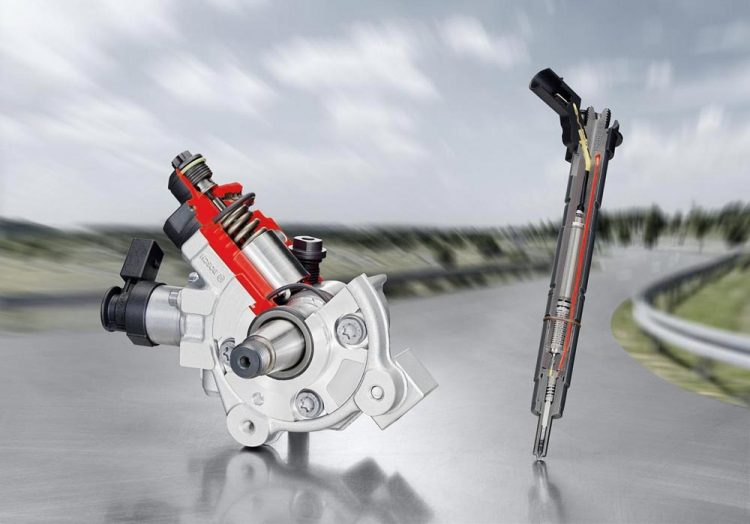Hardened steels for more efficient engines

Injection pumps and injectors, such as the Bosch Common Rail System CRS3-25, generate pressures of 2500 bars thanks to hardened steel. (Source: Bosch) Source: Bosch
Combustion engines still have much potential to save energy and reduce emissions. The present trend is to use smaller engines of the same or even increased power. Engines with a reduced cylinder capacity consume less fuel due to their smaller weight, smaller friction, and smaller amount of exhaust heat.
This so-called downsizing, however, is associated with even higher mechanical and thermal loads acting on the already highly loaded components of diesel injection systems, for instance. Diesel injection systems have to reach higher injection pressures and improved injection accuracies in order to meet the requirements of downsizing. Hence, injection nozzles have to be made of highly stable materials.
An attractive and inexpensive option is the use of low-alloy steels, i.e. types of steel containing not more than five mass percent of metals other than iron. Such steels can be machined well in the soft state and are then hardened for use.
A hard surface with a tough core is obtained. Scientists of KIT's Engler-Bunte Institute are now working on a new process for the case-hardening of steel, namely, low-pressure carbonitration: At temperatures between 800 and 1050°C and total pressures below 50 millibars, the surface of the components to be hardened is specifically enriched with carbon and nitrogen and subsequently hardened by quenching. The project headed by David Koch is aimed at studying the fundamentals of low-pressure carbonitration and developing this process to maturity in cooperation with research and industry partners.
“Low-pressure carbonitration combines the advantages of low-pressure processes with those of atmospheric carbonitration,” David Koch explains. Atmospheric carbonitration damages the surface of the components treated by oxidation. This can be prevented by low-pressure processes. In addition, a more homogeneous hardness profile is generated in the component, in particular in case of complex component geometries.
So far, low-pressure carbonitration has been carried out nearly exclusively using ammonia as a nitrogen donor together with a carbon donor, i.e. ethyne or propane. The KIT scientists have now studied other gases and gas mixtures for suitability for low-pressure carbonitration. Their efficiency in enriching the surface layer with carbon and nitrogen was tested using a thermobalance.
Together with researchers of Robert Bosch GmbH, Stuttgart, they found that methylamine (CH3NH2) and dimethylamine ((CH3)2NH) process gases cause a good enrichment of the surface layer with carbon and nitrogen. The results obtained for low-pressure carbonitration with methylamine are now presented in the HTM — Journal of Heat Treatment and Materials.
When using methylamine for low-pressure carbonitration, only one gas instead of two is required and the usually applied two process steps can be reduced to a single one. Compared to the use of ammonia as nitrogen donor together with a carbon donor, methylamine alone reaches a higher nitrogen enrichment in the surface layer.
As carbon enters the surface layer in parallel, the process duration is shortened considerably. Methylamine also allows for carbonitration at much higher temperatures, which additionally shortens the process duration. Moreover, the degree of utilization of methylamine as a process gas is better, as a result of which the amount of gas used can be reduced.
The KIT scientists are now working on further optimizing low-pressure carbonitration with amines. Work focuses in particular on improving the homogeneity and free adjustment of carbon and nitrogen input. The next goal is to transfer the process from the laboratory to the pilot scale.
###
D. Koch, L. Hagymási, T. Waldenmaier, S. Bajohr, R. Reimert: Niederdruck-Carbonitrieren mit Aminen. HTM — Journal of Heat Treatment and Materials. 70 (2015) 4; pages 171 – 182. DOI: 10.3139/105.110263
Karlsruhe Institute of Technology (KIT) is a public corporation pursuing the tasks of a Baden-Wuerttemberg state university and of a national research center of the Helmholtz Association. The KIT mission combines the three core tasks of research, higher education, and innovation. With about 9,400 employees and 24,500 students, KIT is one of the big institutions of research and higher education in natural sciences and engineering in Europe.
Since 2010, the KIT has been certified as a family-friendly university.
Media Contact
All latest news from the category: Machine Engineering
Machine engineering is one of Germany’s key industries. The importance of this segment has led to the creation of new university degree programs in fields such as production and logistics, process engineering, vehicle/automotive engineering, production engineering and aerospace engineering among others.
innovations-report offers informative reports and articles covering technologies such as automation, motion, power train, energy, conveyor, plastics, lightweight construction, logistics/warehousing, measurement systems, machine tools and control engineering.
Newest articles

Properties of new materials for microchips
… can now be measured well. Reseachers of Delft University of Technology demonstrated measuring performance properties of ultrathin silicon membranes. Making ever smaller and more powerful chips requires new ultrathin…

Floating solar’s potential
… to support sustainable development by addressing climate, water, and energy goals holistically. A new study published this week in Nature Energy raises the potential for floating solar photovoltaics (FPV)…

Skyrmions move at record speeds
… a step towards the computing of the future. An international research team led by scientists from the CNRS1 has discovered that the magnetic nanobubbles2 known as skyrmions can be…





















